The challenge
A review by Scotland’s Technology Enabled Care (TEC) programme in 2020 showed that while most people with Covid-19 recovered, certain groups were at high risk of quickly deteriorating.
Identifying ‘silent hypoxia’ – the presence of low oxygen levels in a patient who might not otherwise seem unwell – helps clinicians identify early signs of deterioration and intervene to improve outcomes.
Solution
A clinical advisory group of experts from general practice, infectious diseases, respiratory medicine, intensive care, emergency medicine, the Scottish Ambulance Service and NHS24 designed the Covid-19 Remote Health Pathway to detect and manage early deterioration among Covid-19 patients.
The pathway went live in January 2021 and enabled people who had Covid-19 symptoms below the threshold for hospital admission to self-monitor their condition. The patient uses a pulse oximeter to monitor oxygen levels, answers a series of questions and provides vital signs readings requested by the Inhealthcare platform.
All patients have a choice of communication channels to submit their readings, either via SMS text messages, online/app, patient portal, or automated calls to a landline or mobile phone. Any readings of concern triggered advice to call NHS services.
“During the design phase of the pathway, the project team worked closely. There were regular reviews and Inhealthcare was able to respond quickly and efficiently to requirements. We were delighted by the findings of the evaluation which showed that patients who were remotely monitoring their symptoms had positive experiences of using the system and that staff felt engaged and supported. We have no doubt that the Covid-19 RHP can safely be rolled out to others”. Bryn Sage, Inhealthcare CEO
Evaluation
An evaluation of the service by Dr Helen Alexander for the TEC Programme has been carried out based on on analysis of submitted readings, patient interviews and staff surveys. The study focused on 149 patients.
The study found:
- The pathway improved access to NHS services for those in greatest need with the most severe symptoms and lowest oxygen saturation levels.
- Patients had positive experiences of using the service. Many felt reassured and that it “stopped you worrying”.
- Patients said they appreciated knowing what their monitoring levels should be following a Covid-19 diagnosis.
- Most patients said they would be happy to use it again.
- Staff felt supported and engaged, describing the system as “useful and easy to engage with” and most felt the trigger levels were about right for patients.
It also indicated that the service contributed to:
- Increased self-management among patients as patients learned how to use a pulse oximeter for oxygen saturation levels and when to take action.
- Effective and efficient use of time and resources for staff and patients . It avoided the need for some in-person contact which left healthcare resources for other patients who may need them more.
- Reduced health inequalities with more than twice as many people from disadvantaged areas using the system than those from affluent areas. There was no evidence to suggest that being less digitally included was a barrier.




